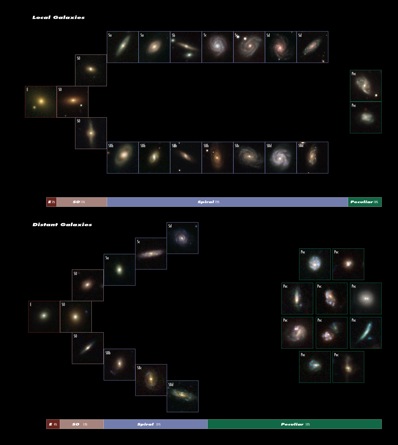
Forming present day
spiral galaxies
DR EMILY BALDWIN
ASTRONOMY NOW
Posted: 08 February 2010


A new demographic census of galaxy types in the local and distant Universe suggests that more than half of the present-day spiral galaxies had so-called peculiar shapes only six billion years ago thanks to merging and collision events.
Studies of galaxy morphology and formation models is an important subject in astronomy. Edwin Hubble's 1926 'tuning-fork' diagram classifies galaxies into four broad categories – elliptical, lenticular, spiral and irregular, but how they are related in evolutionary terms is much debated.
 In this new survey, many more peculiar shaped galaxies (marked Pec) are seen among distant galaxies (bottom image) than among local galaxies (top image), implying that many peculiar galaxies become large spirals through 'spiral rebuilding'. Image: NASA, ESA, Sloan Digital Sky Survey, R. Delgado-Serrano and F. Hammer (Observatoire de Paris). In this new survey, many more peculiar shaped galaxies (marked Pec) are seen among distant galaxies (bottom image) than among local galaxies (top image), implying that many peculiar galaxies become large spirals through 'spiral rebuilding'. Image: NASA, ESA, Sloan Digital Sky Survey, R. Delgado-Serrano and F. Hammer (Observatoire de Paris).
Now, in a new study led by Francois Hammer of the Observatoire de Paris, a team of European astronomers have completed a demographic census of galaxy types at two different points in the Universe's history – the current, or local Universe and the distant Universe. The result is, effectively, two Hubble sequences that together help explain how galaxies form. Cataloguing 116 local galaxies and 148 distant galaxies, the researchers revealed that the sequence six billion years ago was very different from the one that astronomers see today.
“Six billion years ago, there were many more peculiar galaxies than now – a very surprising result,” says Rodney Delgado-Serrano. “This means that in the last six billion years, these peculiar galaxies must have become normal spirals, giving us a more dramatic picture of the recent Universe than we had before.”
Merging events and collisions between galaxies are already well known to change the appearance of galaxies – it is widely believed that merger events are responsible for the formation of elliptical galaxies – but the new study shows that these cosmic collisions can also produce spiral galaxies. In this scenario, peculiar galaxies affected by gas-rich mergers are slowly reborn as giant spirals with discs and central bulges.
Furthermore, it was previously believed that merging events were tapering off around eight billion years ago, but the new study suggests that mergers were still common as recently as four billion years ago. “Our aim was to find a scenario that would connect the current picture of the Universe with the morphologies of distant, older galaxies – to find the right fit for this puzzling view of galaxy evolution”, says Hammer.
As for the formation and evolution of our own spiral Galaxy, the Milky Way, it seems to have been spared from such tumultuous collision events, however, the nearby spiral galaxy Andromeda fits well into the "spiral rebuilding" scenario coined by Hammer and his team.
As well as data from Hubble's Advance Camera for Surveys, the astronomers used data from the Sloan Digital Sky Survey (SDSS) undertaken by Apache Point Observatory.
|



